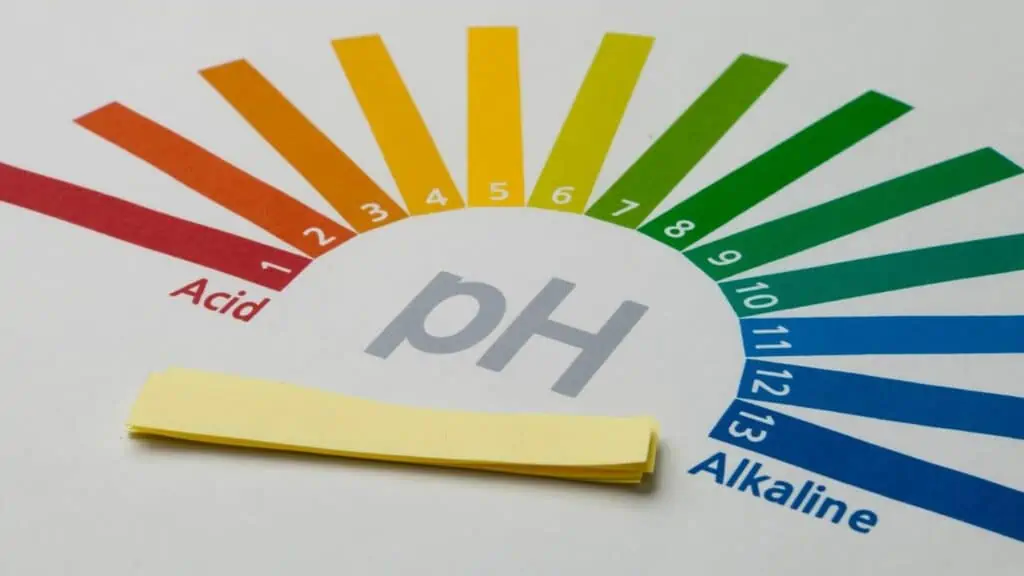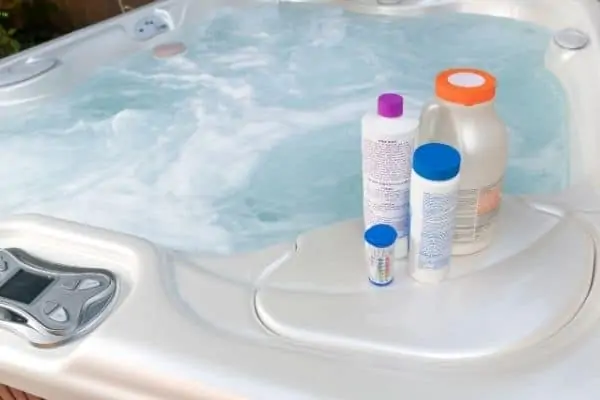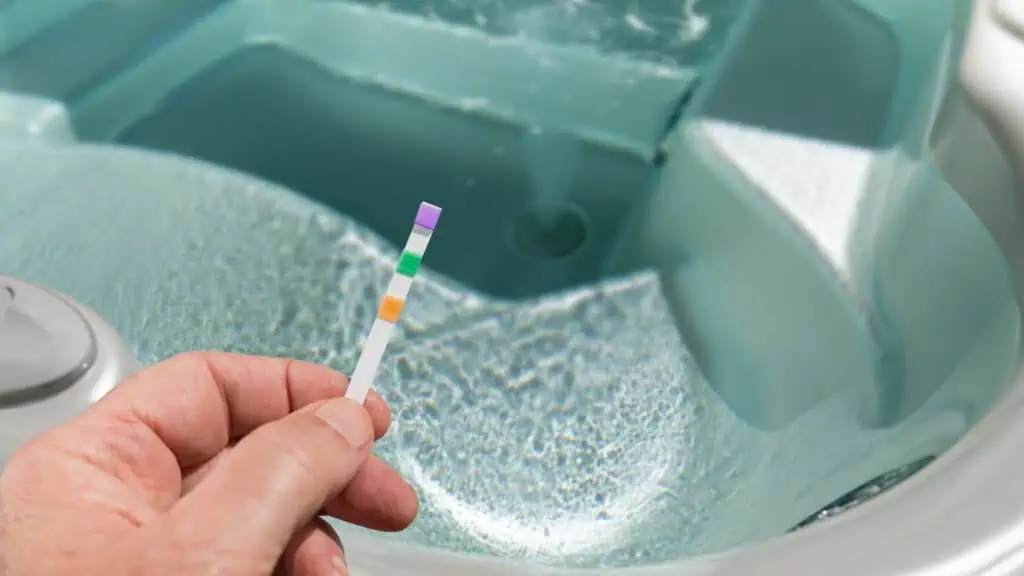A hot tub is a wonderful addition to a home, but you need to learn how to care for its water to keep it clean.
If you are having problems with your hot tub’s alkalinity level, you will find ways to help you with its care.
Many hot tub owners get confused between pH and alkalinity, believing them to be the same thing. So, first, we will explain the difference.


Understanding total alkalinity
pH measures the actual acidity or alkalinity level of a solution. So if the pH reading was 9, then the solution would be alkaline.
Total alkalinity measures the amount of alkalinity in the hot tub water. For example, baking soda has a pH of around 8.2. A weak solution of this would have this pH, but if you added lots more baking soda, the pH would still be 8.2. However, the total alkalinity would be much higher since there would be lots of baking soda in the hot tub.
An ideal alkalinity level in your hot tub maintains the pH and water chemistry equilibrium. Troubles like corrosion and much more follow when this alkaline level drops.
The simple method to increase the hot tub’s alkalinity levels is to add an alkalinity increaser to the water. You can also increase the alkaline level of the water by adding baking soda (sodium bicarbonate), which, if you look at the labels, is often what is contained in more expensive alkalinity increasers anyway.
You will learn more about all this and understand why your hot tub is dropping from its ideal alkaline level in this article.
What causes low alkalinity in hot tub?
You maintain the ideal total alkaline level in your hot tubs and pools as imbalanced alkaline can cause many troubles, which we will discuss later. Your hot tub’s ideal alkalinity range lies between 80 and 120 parts per million (ppm). The alkaline levels might drop below 80 ppm due to the following reasons:
Acidic water
Acidic water is a hot tub’s primary cause of poor total alkalinity. When too many chemicals or a high dose of any chemical is added to hot tub water, it becomes acidic and alkalinity drops. When this happens, the water’s alkalinity falls below acceptable levels.
Temperature fluctuations due to rainwater
The water temperature in a hot tub is normally above 100 degrees Fahrenheit. Rainwater, on the other hand, can reach temperatures as low as 35 degrees Fahrenheit.
So, if your hot tub is outdoors and uncovered when rainfall enters it, it creates a continual rise and fall in water temperature, resulting in low total alkalinity. Otherwise, if you fill your hot tub with just rainwater, that will also be more acidic than normal water.
If you don’t have a cover, there is an easy solution — buy one or replace your old leaky one! To find one suitable for your hot tub, check out the Florida Spa Covers website.
Contaminants
When you relax in your hot tub, you might bring in a lot of pollutants, which modifies the water’s chemistry. Sweat and probably urine are among the contaminants, as is a chemical residue that may be present in your swimsuit and body oils.
These, in turn, cause lower alkalinity in your hot tub water.
Using Epsom salts in a hot tub can also affect the alkalinity.
Excessive alkalinity reducer
Low alkalinity in the hot tub is also possible if you use too much alkalinity reducer. Products that you use as alkalinity reducers are quite acidic. If you use too many of these reducers, your hot tub may reach very low levels of alkaline.

Is low alkalinity bad in a hot tub?
Low total alkalinity (that is, an alkaline level below 80 ppm) can damage both equipment and the body.
Hot tub damage
When low total alkalinity is present, staining, etching, delamination, and cracking can occur on your tub’s surface. A vinyl cover can also deteriorate with time, becoming stiff and brittle.
Metal corrosion
Despite the fact that most tubs are made of fiberglass, lower-alkalinity water can still cause corrosion. This may happen on any metal surfaces in the tub, as well as within machines like the circulation pump and filter.
Bacteria & algae buildup
Hot tub sanitizers (especially chlorine) become less effective at low alkaline levels. So, you need to add more to have the same sanitizing effect. Otherwise, algae and other microorganisms can flourish in your hot tub (causing green tubs).
Skin irritation
Low alkalinity causes the water to become acidic, which further irritates the people using the hot tub. It might cause itchy, dry skin and also irritate the eyes and nasal passages.
pH bounce
When alkalinity is low, pH “bounces” or changes quickly. You can boost the pH, but it only lasts a few hours.
Hot Tub Maintenance Course
I bought Swim University’s Hot Tub Maintenance Course a while after I bought my first hot tub and struggled to maintain it. It was very well spent and has paid for itself many times over the years as I have saved by not needing to use as many chemicals as I did previously.
Listen to our Hot Tub Course Review Podcast:
How to increase alkalinity in a hot tub
Now, how do you balance the alkalinity in a hot tub? Well, it is fairly simple. You must measure and add an alkalinity increaser or a base solution, such as baking soda, to your hot tub water. Just remember to keep the jets running.
Here is a step-by-step guide on how to raise the total alkalinity in a hot tub:
Step 1: Test the water

You must also know the actual level of alkalinity in the hot tub to determine how much of the alkalinity increaser to add to bring it up to the appropriate range. You can test the water using digital testers, test strips, or a testing kit.
Recommended Test Strips
Step 2: Turn the jets on
Keeping the jets on ensures the water is circulated well around the hot tub. This further ensures that the alkaline increaser is fully dispersed in your tub water easily and quickly.
Step 3: Measure and add products to raise alkalinity
Once the jets are on, you can add the alkalinity-balancing products to your hot tub water. There are two main methods to balance alkaline levels.
Baking soda method
Can you use baking soda to increase the alkalinity in your hot tub? Of course you can! Sodium bicarbonate (baking soda) is the best product for increasing overall alkalinity levels in hot tubs.
Baking soda also has the advantage of being a highly safe chemical. Most importantly, it will have a minimal effect on the pH level of the water.
Soda ash method
To compensate for the low total alkalinity level in hot tubs, you can also use soda ash, often known as sodium carbonate. However, it also acts as a pH increaser. This means it can cause a high pH level in the water.
Both methods use the same steps, but the chemical differs. Follow these steps to raise alkalinity using the above two methods.
- Measure the amount of chemicals needed. Ideally, 1000 gallons of water needs about one tablespoon of baking soda or soda ash to maintain the ideal alkaline level.
- Add the required amount to a bucket of water.
- Stir the mixture with a wooden spoon.
- Pour the mixture directly into the hot tub, spreading evenly.
- Let the water circulate for a few hours.
Step 4: Test the water again
Finally, test the water again using a test strip or something else. The water’s alkaline balance must have been restored by now. If alkalinity is still low, adjust again by repeating the above two steps using baking soda or soda ash.
The chemistry of alkalinity level and pH
While alkalinity and pH are not the same, they are closely interlinked, and one can affect the other. Water pH measures the quantity of hydrogen (acid ions) in water, whereas water alkalinity measures the amounts of carbonate and bicarbonate in water. You want your hot tub water to be between 7.2 and 7.8 on a pH scale.
In this section, you will address the following questions:
- Can you raise alkalinity without causing a high hot tub pH level?
- What should be adjusted first: alkalinity or pH?
Firstly, we suggest using sodium bicarbonate or baking soda instead of soda ash, as discussed above, as your alkalinity increaser. The former has a much smaller effect on the hot tub’s pH levels.
First, adjust the water’s alkalinity. Once alkaline levels are optimum, use muriatic acid or sodium bisulfate to bring your hot tub’s pH level back to optimum.







Leave a Reply